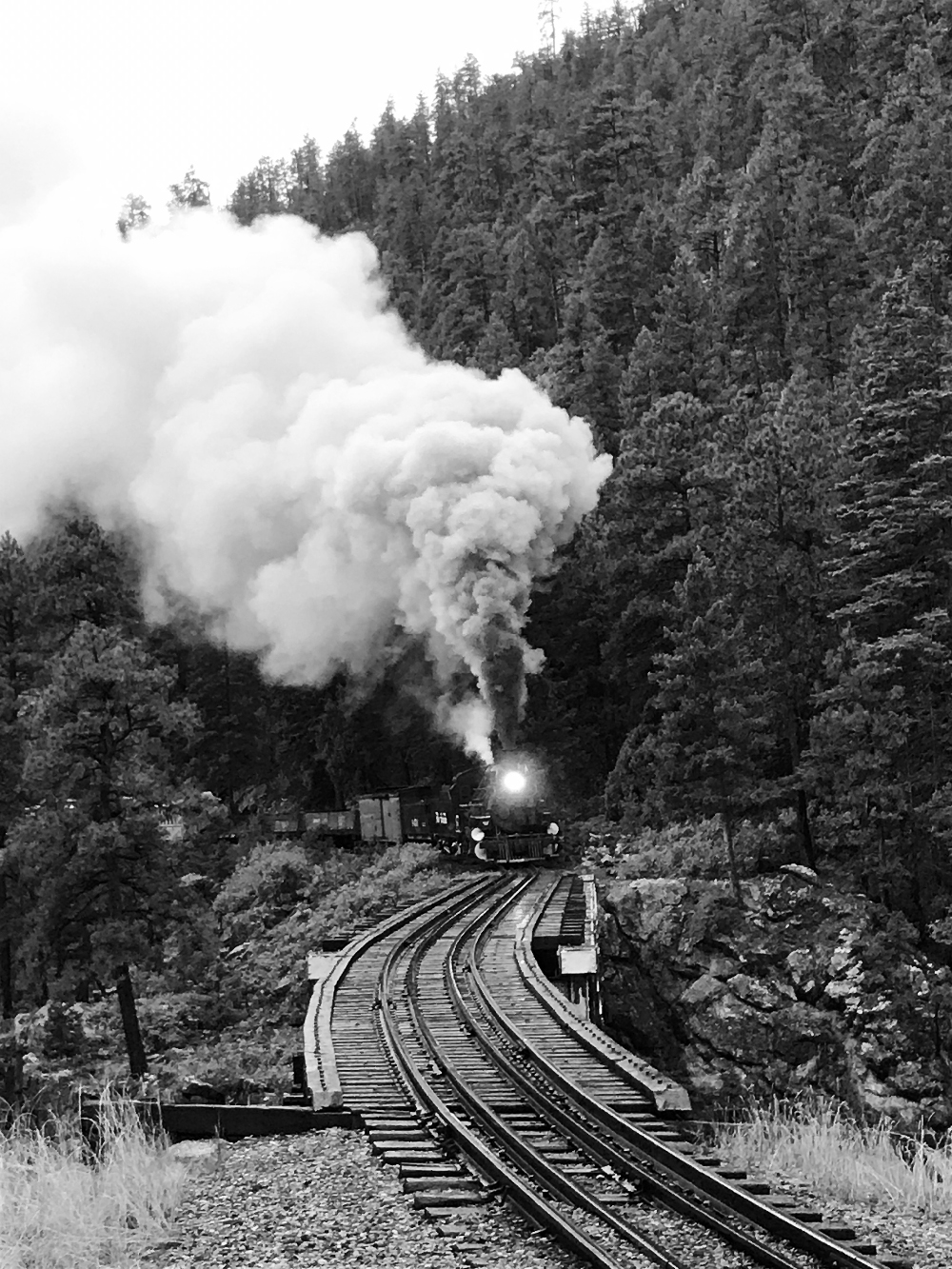
It does not matter how many times you have traveled the Durango & Silverton Narrow Gauge Railroad between its namesake cities. Every time you ride is a new adventure. The scenery evolves over time and is dependent on the season at hand. The people you ride with change. The purpose of the ride is different. And, the weather, like anytime in Colorado’s San Juan Mountains, can change in the blink of an eye.
Recently, I accompanied a Trains photo charter on the D&SNG. We traveled from Durango, Colo., the first day, overnighted in Silverton, Colo., and returned the next. The mission: Photograph the railroad in all its fall glory and capture narrow-gauge steam in the first significant snowfall of the season. Do you remember what I said about the weather? Conditions changed minute-by-minute and mile-by-mile. We experienced heavy rain, sleet, hail, lightning and thunder — some too close for comfort — heavy, wet snow, and bright mountain sun. The San Juans served up some interesting conditions that presented both photographic challenges and rewards.
For this expedition, the charter staff along with our conductor and brakeman took up headquarters in one of D&SNG’s two cabooses. Ours, No. 0540, was delivered to the Denver & Rio Grande in 1891. It is doubtful that D&RG officials of the 1890s would understand the concept of a photo charter, much less a group of people 133 years later being excited about riding in a caboose.
Riding No. 0540 checked a number of boxes on the list of ever-changing D&SNG experiences. The view was different from a regular passenger car. There are multiple perspectives on the scenery to be had from the caboose. Traveling the D&SNG in a caboose is something I had not done previously. And, the caboose itself contributed its own character to the adventure.
Welcome aboard No. 0540
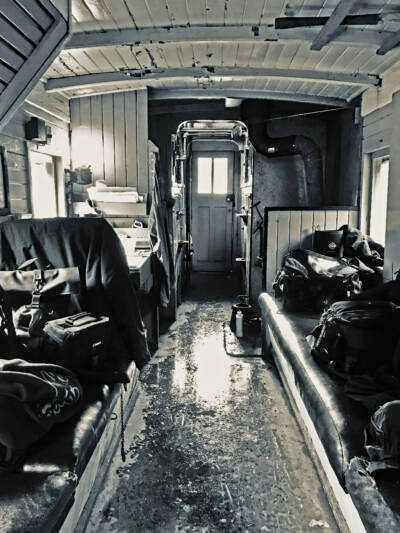
Designed as the road office and home for conductor and brakeman, cabooses, in general, are not luxury accommodations ranking even close to the lowliest passenger train. No. 0540 followed suit. From the front the interior featured two leather-cushioned bench seats, which beneath the seat doubled as storage bunkers. In the right front corner there is a floor-to-ceiling wooden locker holding the brakeman’s flagging supplies. Above the bench seats, toward the front, two fold-down bunks were mounted to the walls and ceiling. After the benches, the right side gave way to a built-in conductor’s desk with a small bench seat. The other side held a sheet-metal-wrapped cubby fitted with a traditional pot-bellied coal stove. The last third of the No. 0540’s floor space is devoted to additional wooden storage cabinets, cleverly arranged under the raised cupola. After the cupola a final set of cubbies finished the interior. In this last set, one side was a simple counter; the other while a counter held our conductor’s small gas camping-style cookstove.
The interior decor was nothing that will ever be written up in Architectural Digest; but then this is a working, utilitarian caboose. Well worn, cracked, black leather upholstered the various benches. The walls, floor, ceiling — just about everything — was presented in a shade of locomotive-cab green, which was faded in places, and chipped and cracked everywhere. Paint that was not marred physically bore the dirt and grim accumulated through years of service.
To complete the interior, the roof and ceiling played a capping role — they leaked. As if to remind us inside the caboose that outside it was raining, sleeting, snowing and spitting hail, the ceiling developed a series of randomly rotating dribbles, sending small, yet steady, water droplets streaming downward onto selected targets. Unbeknown to me, one of those targets was my jacket, hung by the stove in hopes that it would dry from a foray into the elements outside the caboose. To my chagrin, the jacket would have dried faster had it been left out in the pouring rain.
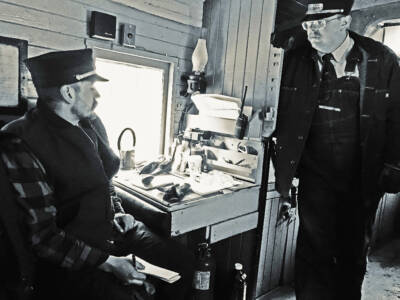
Please do not cast my description of No. 0540 in a negative light. If you are ever offered the opportunity to ride in an authentic caboose … take it! The less-than-glamorous interior, rougher-than-usual ride and unanticipated overhead water service are part of the experience. There are not that many places that one can ride a caboose these days and to do so with the San Juan Mountains as the backdrop — climb aboard, ride the caboose. Period.
Six little postcards
As the train progressed upward toward Silverton, another caboose feature struck my eye. Above the long benches, each side of the car featured three windows, evenly spaced mid-car, measuring about a foot-and-a-half by two feet. Sitting on one long bench, looking out the opposite three windows, the passing scenery was framed, moving from window to window as if a series of picture postcards was continually rolling by. This view is radically different from a standard coach with its ribbon of windows along each side. While not expansive, the caboose windows focus the scenery, accentuating details otherwise missed in the bigger picture. One notices how a tree fell, not just that another tree went down in the forest. A waterfall’s path is carefully traced as the water tumbles to the river below, not that we are passing another waterfall. A low-flying hawk glides from window to window. You focus on how it moves its wings, not just that it has passed your vantage point. Throughout the entire trip, those six little postcards presented an ever-changing view of the San Juans.
Turn up the heat, please
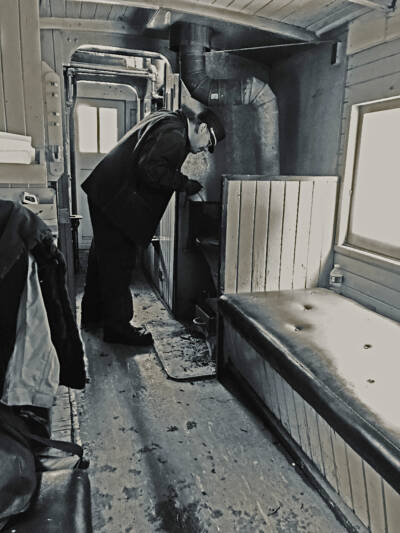
Caboose stoves are the stuff of legend and detriment. When the caboose was a required train car, the stove heated the coffee pot, provided a cooking surface and warmed the interior. Just the right fire provided satisfactory heat, while an excessive fire turned the caboose into a mobile oven. Brakeman “Beans” filled the firemaster role, attempting to set the perfect temperature through careful combustible tinkering. Beans faced an uphill battle to start — any tinder he could find was wet and the coal supply damp — a combo pack that does not create a fire quickly. (This situation also slowed the drying of my aforementioned soaked jacket.) However, his pyro-technical wizardry — a wad of flaming paper towel drying a few twigs, which ignited several small coal lumps eventually leading to glowing larger lumps — produced just the right amount of heat to make No. 0540 snug, comfortable, and far less damp than the Animas River roaring along the tracks.
The end to the end
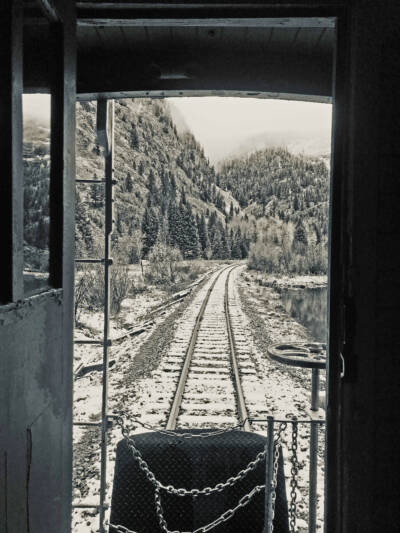
Depending on how you debate the point, it is interchangeable as to whether the cupola or back platform is the preferred accommodation aboard a caboose. The cupola with its raised, 360-degree view offers an interesting perspective. The back platform provides an expansive rear-facing view along with an enhanced railroad soundtrack. It’s your call.
On the return to Durango, I spent several stints on the back platform. With the tracks receding into the distance, the scenery of the San Juan Mountains and the Animas River Canyon unfolded. Words really cannot describe how beautiful this was. In one direction, mountain peaks reaching upwards of 14,000 feet above sea level, capped with fresh snow. Looking down, the Rio de las Animas Perdidas — the Animas River, the river of lost souls — roars and tumbles through the rapids more than 300 feet below. In between, a haze of locomotive smoke whisps through the lush green pines, which are punctuated by bursts of bright yellow aspen leaves in the last glorious celebration of fall.
There is a final perk to the back platform. As we entered Durango, whistling for every grade crossing, little knots of people waited for the train to pass. Standing on the back platform allowed for dozens of friendly waves and smiles to be exchanged as we neared the depot. In my youngest years, I fully remember exchanging such greetings with the conductor and brakeman as a freight train passed. To fulfill that role in 2024 from the back platform of an 1891 caboose — words really cannot describe the sensation.
Ride the caboose. It’s an experience you won’t soon forget. Period.
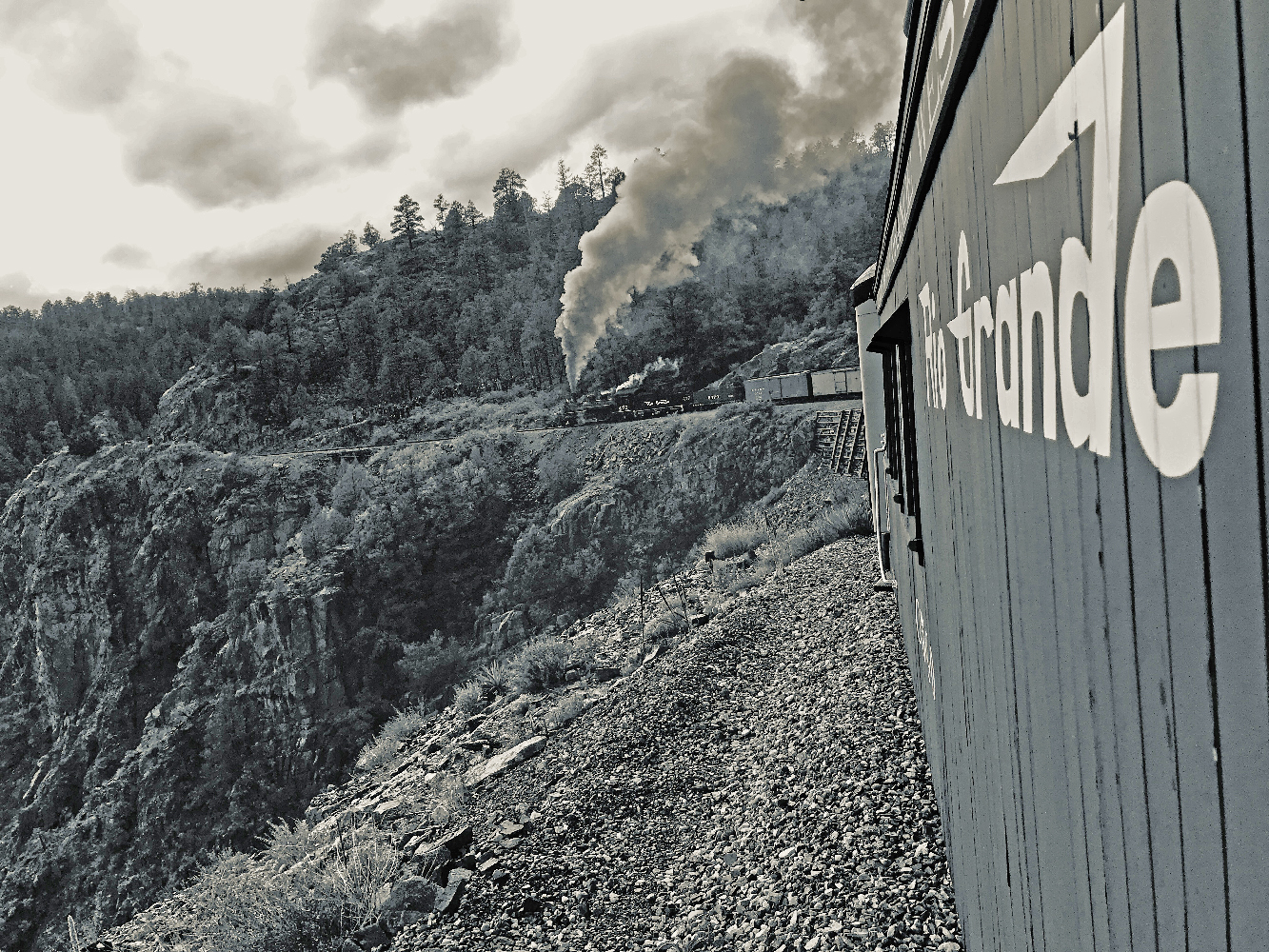














well done, it is nice to read a ‘railroad’ story with such an Elligent description of an old everyday event that now is elevated to something to hold on to and relish in this strange computer age we live in…..Gazing back and reliving old time events keeps us grounded and hopefully inspires us to understand the past and the people that shaped it . It brings back the wonderful writings of David P Morgan and the true meaning of Trains magazine, hopefully the new owners feel the same way!
That’s a fact, a ride you won’t forget. It was the mid 60’s I was 5 or 6 when our family took a trip on Bill Kratville’s “Cornhusker Club” in South Dakota. The car road on the back of a freight train coupled up to caboose # 14560. As a kid you could imagine how much fun it was hopping between cars on a moving train and climbing up and down in the cupola. Unfortunately I only have 1 photo of that trip, a group shot with the caboose in the background.